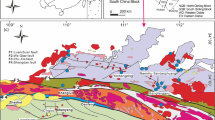Abstract
Low magnetic susceptibility, low Sr content and hence high Rb/Sr ratio in the lake sediment sequence indicate a weak chemical weathering process under arid and cold climate of the Little Ice Age in a single closed lake watershed. According to different geochemical behavior between rubidium and strontium in earth surface processes, variation of Rb/Sr ratios in the lake sediment sequence can be used as an effective geochemical proxy with definite climatic significance of chemical weathering in watershed. Unlike chemical weathering process in tropic zone and modern temperate-humid climate, concordant changes in both Sr content and magnetic susceptibility with δ18O values of Dunde ice core suggest that the weak chemical weathering was controlled by air temperature during the Little Ice Age maximum. After the Little Ice Age, chemical weathering intensity was controlled also gradually by precipitation with increasing in temperature.
Similar content being viewed by others
References
Blum, J. D., Gazis, C. A., Jacobson, A. D. et al., Carbonate verse silicate weathering in the Raikhot watershed within the High Himalayan Crystalline Series, Geol., 1998, 26: 411–414.
Lasaga, A. C., Soler, J. M., Ganor, J. et al., Chemical weathering rate laws and global geochemical cycles, Geochim. Cosmochim. Acta, 1994, 58: 2361–2386.
PAGES, Paleoclimates of the Northern and Southern Hemispheres, Bern: Pages Press, 1995, 1–92.
McFarlane, A. W., Geology and major and trace element chemistry of late Archean weathering profiles in the Fortescue Group: implications for atmospheric CO2, Precam. Res., 1994, 65: 297–317.
Brady, P. V., Carroll, S. A., Direct effects of CO2 and temperature on silicate weathering: possible implications for climate control, Geochim. Cosmochim. Acta, 1994, 58: 1853–1856.
Glodstein, S. L., Decoupled evolution of Nd and Sr isotopes in the continental crust and the mantle, Nature, 1988, 336 733–738.
Chen, J., An, Z., Head, J., Variation of Rb/Sr ratios in the loess-paleosol sequences of Central China during the last 130000 years and their implications for monsoon paleoclimatology, Quart. Res., 1999, 51: 215–219.
Dasch, E. J., Strontium isotopes in weathering profiles, deep-sea sediments, and sedimentary rocks, Geochim. Cosmochim. Acta, 1969, 33: 1521–1552.
Chen, J., An, Z., Wang, Y. et al., Distribution of Rb and Sr in the Luochuan loess-paleosol sequence of China during the last 800 ka—Implications for paleomonsoon variations, Science in China, Ser. D, 1999, 42(3): 225–232.
Cao, J., Shen, J., Jin, Z., Geochemical record for climatic reconstruction during the Little Ice Age in Daihai Lake, Inner Mongolia, J. Nanjing Normal. Uni. (Natural Science Edition) (in Chinese), 2000, 23(4): 247–251.
Chen, J., Ji, J., Qiu, G. et al., Geochemical studies on the intensity of chemical weathering in Luochuan loess-paleosol sequence, China, Science in China, Ser. D, 1997, 40(6): 531–536.
Ingram, B. L., Sloan, D., Strontium isotopic composition of estuarine sediments as paleosalinity—paleoclimate indicator, Science, 1992, 255: 68–72.
Grove, J. M., The Little Ice Age, London: Methuen Co. Ltd., 1988, 199–230.
Zhu, K., A preliminary study on the climatic fluctuation during last 5000 yearsin China, Scientia Sinica, 1973, 2: 226–256.
Wang, S., Studies on climate of the Little Ice Age, Quaternary Sciences (in Chinese), 1995, 3: 202–212.
Wang, S., Yu, S., Wu, R. et al., The Daihai Lake—Lake Environment and Climate Change (in Chinese), Hefei: University of Science and Technology of China Press, 1990, 1–191.
Shi, Y., Wang, J., The fluctuations of climate, glaciers and sea-level since the late Pleistocene in China, IAHS Publ., 1979, 131: 281–293.
Anderson, R. S., Hallet, B., Simulating magnetic susceptibility profiles in loess as an aid in quantifying rates of dust deposition and pedogenic development, Quart. Res., 1996, 45: 1–16.
Dunne, T., Rates of chemical denudation of silicate rocks in tropical catchments, Nature, 1978, 274: 244–246.
Zhang, L. S., Shi, P. J., Fang, X. Q., The Holocene Environment Evolution of Intersect Zone Between Farming and Herd and Forecasting for Future One Hundred at North China (in Chinese), Beijing: Geological Publishing House, 1992, 1–15.
Yao T., Xie Z., Wu X. et al., The Little Ice Age as recorded in the Dunde Ice Cap, Science in China, Ser. B (in Chinese), 1990,(11): 1196–1201.
Cuffey, K. M., Clow, G. D., Alley, R. B. et al., Large Arctic temperature change at the Wisconsin—Holocene glacial transition, Science, 1995, 270: 455–458.
Gibbs, M. T., Kump, L. R., Global chemical erosion during the last glacial maximum and the present: sensitivity to changes in lithology and hydrology, Paleoceanography, 1994, 9: 529–543.
Author information
Authors and Affiliations
Corresponding author
Rights and permissions
About this article
Cite this article
Jin, Z., Wang, S., Shen, J. et al. Weak chemical weathering during the Little Ice Age recorded by lake sediments. Sci. China Ser. D-Earth Sci. 44, 652–658 (2001). https://doi.org/10.1007/BF02875338
Received:
Issue Date:
DOI: https://doi.org/10.1007/BF02875338




